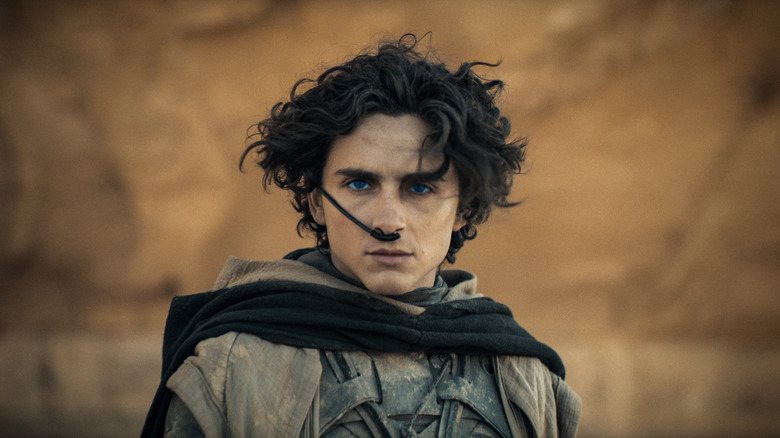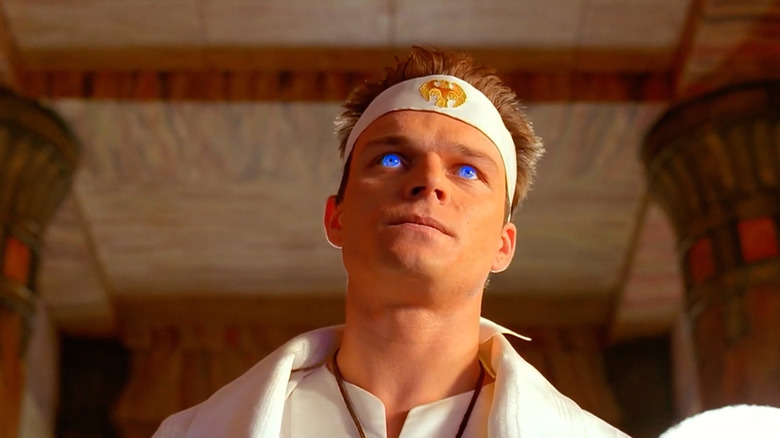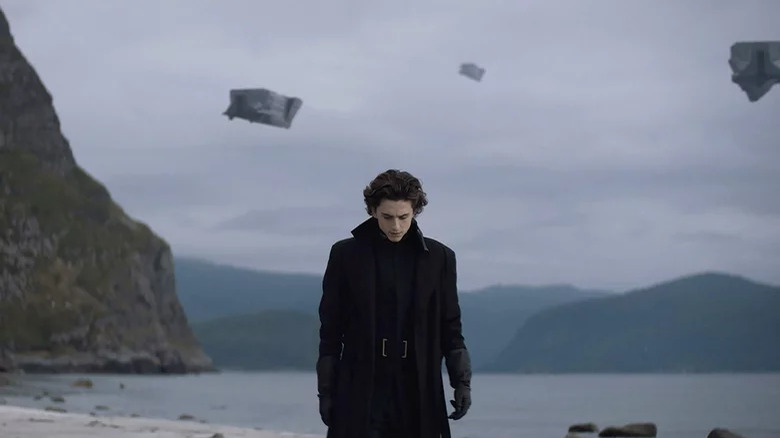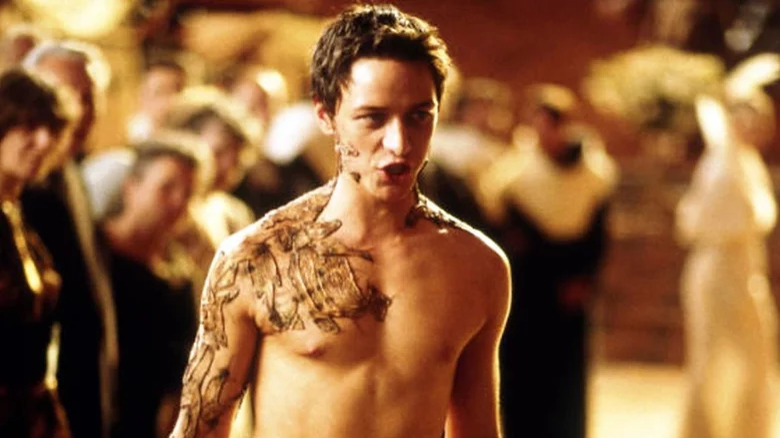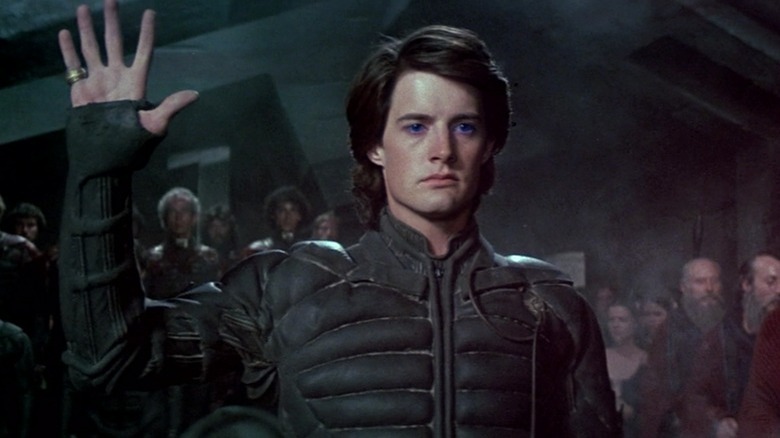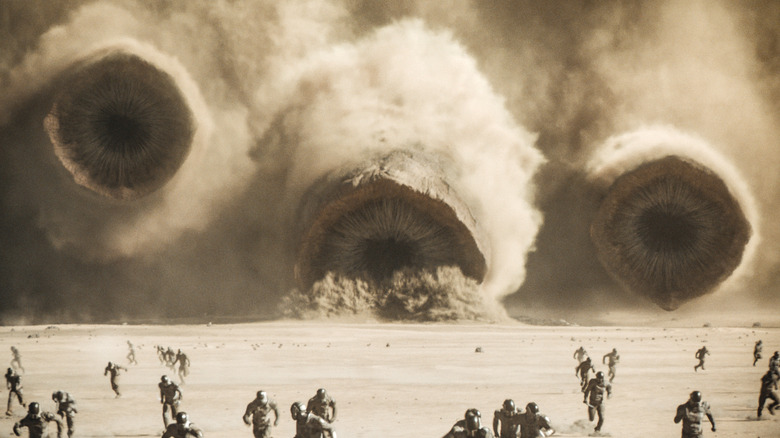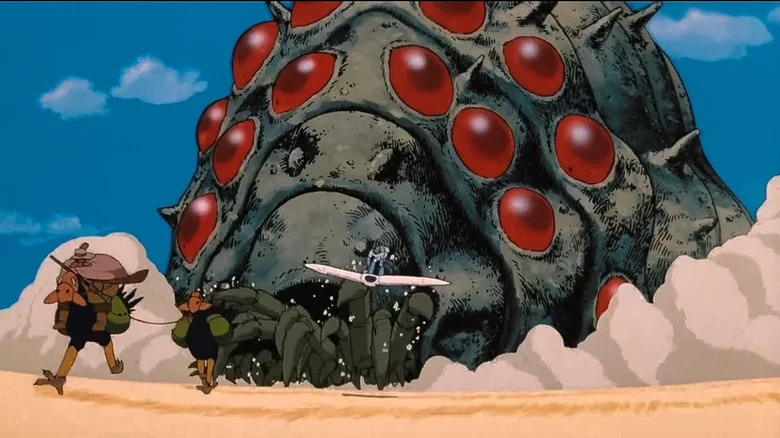Every Dune Adaptation Ranked
Frank Herbert's "Dune" is one of the most influential science fiction books of all time. The original novel remains a groundbreaking story that draws inspiration from the hero's journey or monomyth, environmental science, politics, real history, and Arabic religion and Middle Eastern culture to deliver an unprecedented epic about the dangers of messianic leaders and the importance of ecology.
Ever since its initial publication in 1965, "Dune" has captivated all kinds of audiences, including hopeful producers and executives eager to adapt the story of Paul Atreides and his rise to power into a cinematic event. For a long time, filmmakers kept trying and failing to turn "Dune" into a movie, resulting in Herbert's book being labeled "unadaptable." Since then, however, there have been a handful of movie and TV adaptations, each of them highlighting different aspects of the original novel and its sequels.
With Denis Villeneuve turning "Dune" into a two-part box office reigning blockbuster, it is time to look back and rank every screen version of Frank Herbert's "Dune" — yes, even the mini-series based on the first two sequel books.
5. Frank Herbert's Dune (2000)
Suppose you watched either Villeneuve or David Lynch's adaptation of "Dune" and were left confused about any of the many questions left unanswered in those films (particularly about the state of the larger "Dune" universe). In that case, this is the adaptation for you. The Sci-Fi Channel's "Dune" mini-series is truly the most faithful adaptation of Herbert's source material, taking the text literally and including every possible plot point and character. Not only does the Spacing Guild play a prominent role, but even CHOAM and the Harkonnens finally get their due.
This is an adaptation that truly understands Baron Harkonnen is a crafty, cunning antagonist and not just a pale fat guy who floats. It also fully understands and explores the cycle of spice and its importance to the universe, as well as the cycle of Shai Hulud. Even ecology, a hugely important aspect of Herbert's work, is explored in-depth here, with the mini-series examining how terraforming matters to the Fremen and the work they'd spent centuries doing before Paul's arrival.
What Lynch's "Dune" boasts in art direction, this series has in costume designs. Costume designer Zuzana Máchová goes completely ridiculous in the best way, giving the "Dune" universe a look best described as the extravagance of "Star Wars: Episode I — The Phantom Menace" meets the low-budget TV teen drama of "Power Rangers."
Though the casting is the whitest out of all the adaptations and Paul is miscast, the "Dune" mini-series gets points for actually spending quite a lot of time with the Fremen. We see them as a community, with children playing in the streets, people going on their daily routines, and markets booming. This is not a group sitting idly by waiting for Mahdi but a thriving civilization underestimated by the universe.
4. Dune: Part One (2021)
Where Villeneuve's "Dune: Part One" falls on your personal list likely depends on two things — whether the splitting of the story bothers you, and your thoughts on the film's modernist, more grounded aesthetic. That's because Villeneuve throws away the trippy, alien look of David Lynch's "Dune" and ignores the soap opera-y look and absurd costuming of the "Dune" mini-series in favor of a grounded (at times even dull) modern blockbuster look that focuses on grand vistas over dazzling imagery.
Indeed, this is very much a post-Marvel blockbuster, one that boils down the book to its thematic essence rather than dwelling in its world or tone. "Dune: Part One" spends a lot of time relishing in the grandeur and vastness of Arrakis rather than its beauty. It mostly ignores the larger politics of the universe — the Spacing Guild is barely in here — to instead spend more time on Paul's inner struggle with his future. Though characters like Yueh and Thufir Hawat are all but non-existent in this film, Lady Jessica gets a bigger role, and her relationship with Paul is extended and adapted in fresh ways.
That is because the crux of this film lies in the idea of inevitability and strings. The Atreides are moved by an invisible string, slowly walking toward their doom, and Paul is slowly walking toward his fate as the Kwisatz Haderach. More than any other adaptation, this film has Paul not only confront Jessica about how her Bene Gesserit teachings and eugenics made him a threat but is the only one that has Paul fully aware of the Missionaria Protectiva and the role the Bene Gesserit had in spreading superstition among the Fremen to manipulate them. Also, the film giving Jamis a bigger role is a fantastic choice that plays into Paul's powers.
3. Frank Herbert's Children of Dune (2003)
"Children of Dune" is the crowning achievement of the Sci-Fi Channel's adaptations of Frank Herbert's work, taking advantage of the more talkative and philosophical narrative of Herbert's "Dune Messiah" and "Children of Dune" to deliver a mini-series heavy on dialogue and political intrigue. "Children of Dune" finishes the tragedy of House Atreides, delivering an epic science-fiction soap opera that conveys the weirdest parts of Herbert's world — a human-worm hybrid! — in a way that regular audiences can understand and enjoy.
This last bit is in no small part due to the excellent casting of James McAvoy as Leto II, son of Paul Atreides. McAvoy makes Leto just as much an angsty teen as he is an ominous and omniscient monster. Like his father, Leto II is a tragic figure, embracing the monstrous path ahead of him for the supposed sake of humanity. The Golden Path that Paul shied away from but Leto accepted is presented succinctly — and while the mini-series overly simplifies the text, it makes for a compelling narrative about prescience and free will.
Adapting not just one but two books, "Children of Dune" suffers the most from struggling to make room for so many characters ( (including Jessica, Stilgar, and Duncan Idaho), yet it thrives in streamlining both narratives to create a cohesive whole. Much like the "Dune" mini-series, "Children of Dune" also makes the role of the female characters bigger and more nuanced, particularly that of Wensicia and Alia. Susan Sarandon is having a blast as the conniving heir of House Corrino, while Daniela Amavia is phenomenal in making Alia just as tragic a figure as Paul or Leto II. The deterioration of her mental well-being is emotional and thrilling to watch.
2. David Lynch's Dune (1984)
Though maligned and seen as a misstep in its time and all but disowned by its director, David Lynch's "Dune" is now an anomaly. As our own Joe Roberts has described it, Lynch's "Dune" exists "somewhere between cult classic and historic blunder." The film's biggest strength is how it translates the otherworldly imagery of the book with stunning art direction, impressive sets, and character designs. It also still has the best interpretation of the Spacing Guild Navigators.
Sure, the film race-bended the book and had a pretty white cast, but there's something cool about seeing a bunch of Lynch regulars inhabiting Arrakis. Plus, Sting as Feyd Rautha is an inspired piece of casting, especially when paired with his costuming.
If nothing else, as an adaptation, Lynch's "Dune" makes some fascinating changes and additions. Take the Weirding Module, which replaces the martial arts concept of the "Weirding Way." Though it takes away from Jessica's role in the story, having a sonic weapon that can kill with sound is simply cool, and the moment Paul realizes his very name can kill fits right in with Herbert's world. Of course, there's also the weird yet inspired choice of having Toto compose the score for the movie, which remains unique and quite electrifying. Even in the writing, Lynch's film features the phenomenal line "The sleeper has awakened!" which is so good it should have been in the original book (although the voice-over, while useful, can be a bit distracting).
Unfortunately, Lynch's "Dune" deeply misunderstands and/or ignores the message of the book, turning Paul into an actual white savior with zero interrogation of his role among the Fremen. Still, what it lacks in thematic depth it exudes in visuals. This is a kinky, outlandish, beautiful-to-look-at, and truly alien sci-fi movie.
1. Dune: Part Two (2024)
Now this is (sandworm)podracing! Sure, "Dune: Part Two" is still just a half-film, but even then this is one hell of a good half-film — a bleak, ambitious blockbuster. Everything Villeneuve explored and set up in the first film is paid off in "Part Two," which puts Paul's struggle with fate front and center. It also doubles down on that which is completely absent from Lynch's "Dune" and barely touched upon in the "Dune" mini-series, with "Part Two" delivering an unapologetic story about the dangers of populist leaders and messianic figures, along with an interrogation of the idea of the white savior.
More than "Part One," this is the film where Villeneuve really takes advantage of the IMAX format to deliver some stunning imagery, particularly whenever the sandworms are involved — the final Battle of Arrakeen alone is an incredible piece of blockbuster filmmaking. Admittedly, as an adaptation, the film still overly simplifies the politics of "Dune," ignoring the Spacing Guild and any real explanation as to why exactly spice is so important (or how Paul's actions change the universe beyond making the Harkonnens lose money). Likewise, it removes some of the weirder aspects of the book (although it keeps an important element in a slightly different way), yet it's the story and themes that allow "Dune: Part Two" to become more than just another hollow modern blockbuster.
Villeneuve similarly brings Jessica and Chani to the foreground, offering opposite views on Paul's rise to power and adding conflict to the story that isn't present in the books, but which makes this a richer experience. Though not the most accurate adaptation in its imagery or worldbuilding, "Dune: Part Two" is the only adaptation to truly understand Frank Herbert's skepticism of populist leaders, making this the best adaptation of "Dune."
BONUS: Nausicaä of the Valley of the Wind
Though technically not an adaptation of "Dune," Hayao Miyazaki's early masterpiece "Nausicaä of the Valley of the Wind" shares a lot of similarities with Herbert's novel, particularly in its portrayal of ecology and its importance.
In "Nausicaä," the eponymous warrior princess resides in a small kingdom bordering a poisonous forest harboring giant sandworm-like insects known as the Ohmu. The forest is full of poisonous spores in the air that kill any human who steps into it instantly. The story follows Nausicaä as she finds a way to communicate with the Ohmu, following an ancient prophesy and changing humanity's understanding of the world.
Though the film's take on messiahs and prophecies is almost the polar opposite of Herbert's work — Miyazaki's manga version of the story, however, is much darker and closer in tone to Herbert's writing — the two works are similar where it counts the most: a love of ecology. You see, the thing that no adaptation of "Dune" (not even the mini-series that actually includes this in its plot) has fully nailed is Herbert's love for ecology and how it impacts an entire society.
